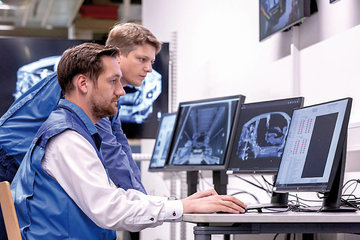HEITEC supports robotic x-ray system for auto manufacturers
04.12.2018

Entire vehicles can now be analyzed at the micrometer level: New robotic x-ray technology raises quality control to a whole new level. Photo: BMW Group
The HEITEC Group is showcasing its expertise in the fields of industrial x-ray technology, automation, and digitalization with a pilot project that uses robot-supported computed tomography in automobile manufacturing. This system allows the quality of entire vehicles to be thoroughly analyzed in an early phase of development without having to take the vehicles apart. The new CT x-ray system, which is unique in the automotive industry, was developed by engineers from the BMW Group and the Fraunhofer Development Center for X-ray Technology (EZRT) in collaboration with HEITEC.
The BMW Group wants to use computed tomography (CT) on its entire range of vehicles, from the MINI to the Rolls Royce, to test various quality parameters during early development phases. To perform these tests, a new x-ray system was installed in a lead bunker measuring 7 x 9 x 4.5 meters at the BMW Group’s research and development center in Munich. The scans are performed by four coordinated robots that operate on two external linear axes. The robots work in pairs: One has x-ray tubes and the other a detector. The x-rays travel from the x-ray tubes through the test object to the detector on the other side. Depending on the inspection task, one of the robots is generally inside the car body and the other outside it. The large industrial robots have a range of three or more meters and can reach virtually any point on the intricately shaped objects. This technology makes it possible to examine the car body with maximum precision and down to the smallest detail without causing damage. Until now, the components being inspected had to be dismantled for analysis and examined in a separate CT system.
Extremely precise components are required in order to achieve high resolutions. The most precise industrial robots of this size are accurate to within a quarter of a millimeter inside their working area, whereas CT requires at least a twentieth of a millimeter, depending on the application. That’s why a specially developed computer program using intelligent algorithms corrects the robots’ geometric inaccuracies and calculates a multilayer, three-dimensional image from a stack of x-ray images. This results in cross-sectional images of the test objects with a maximum computed resolution of under 100 micrometers: the degree of detail required, for example, for inspecting welds and screw connections without damaging them, and for analyzing adhesive joints on the car body.
For this project, HEITEC was responsible for programming and commissioning the robots, for installing the x-ray tubes and detectors, and for implementing the safety technology. HEITEC also implemented the interfaces to the programmable logic controller, to the robots, and to Volex, the analysis software from the Fraunhofer Development Center for X-ray Technology (EZRT).
HEITEC also designed a digital twin for the project that models the system virtually in real time. In the future, it will serve as the basis for automated collision control between robots and test objects. Using the CAD model that already exists during development, the robots’ movements can be coordinated and tested before the real model is scanned, thereby reducing system commissioning and conversion time.
Download (docx, pdf, jpg | 12,6 MB)